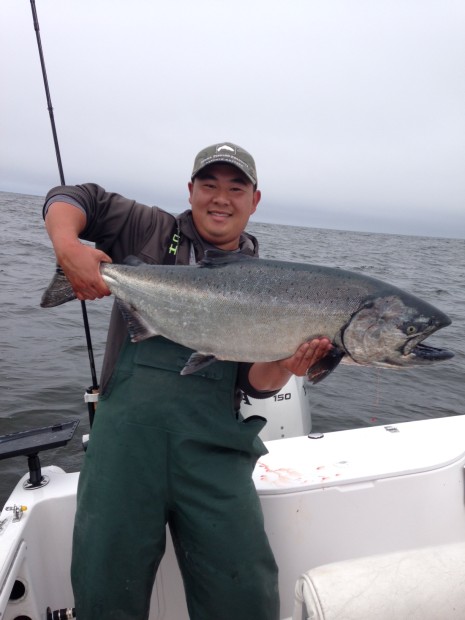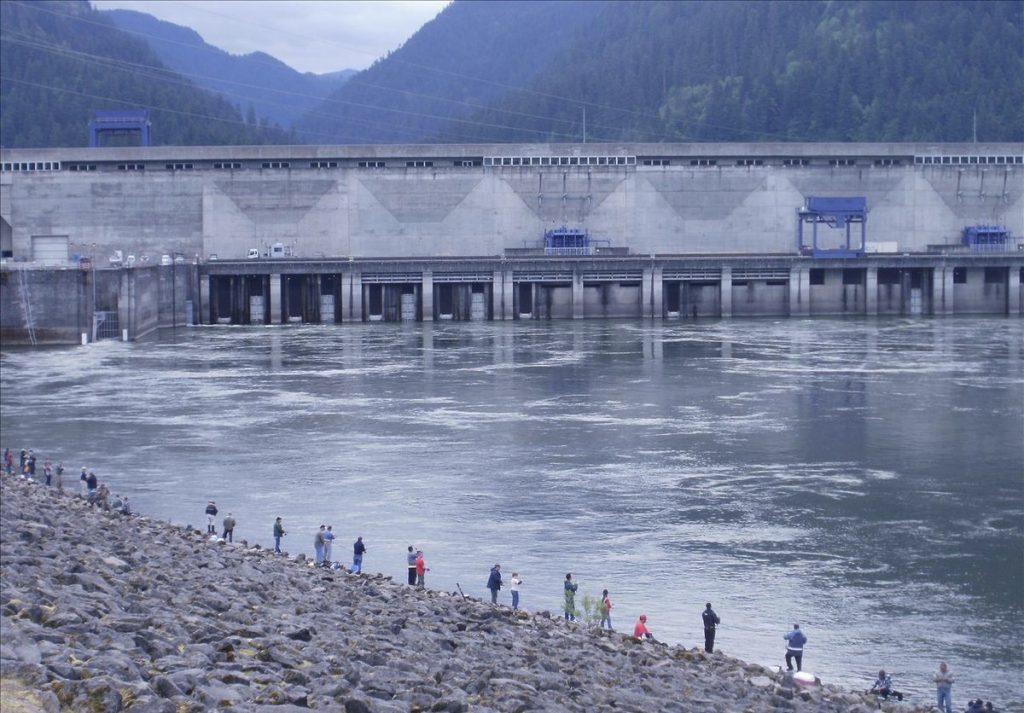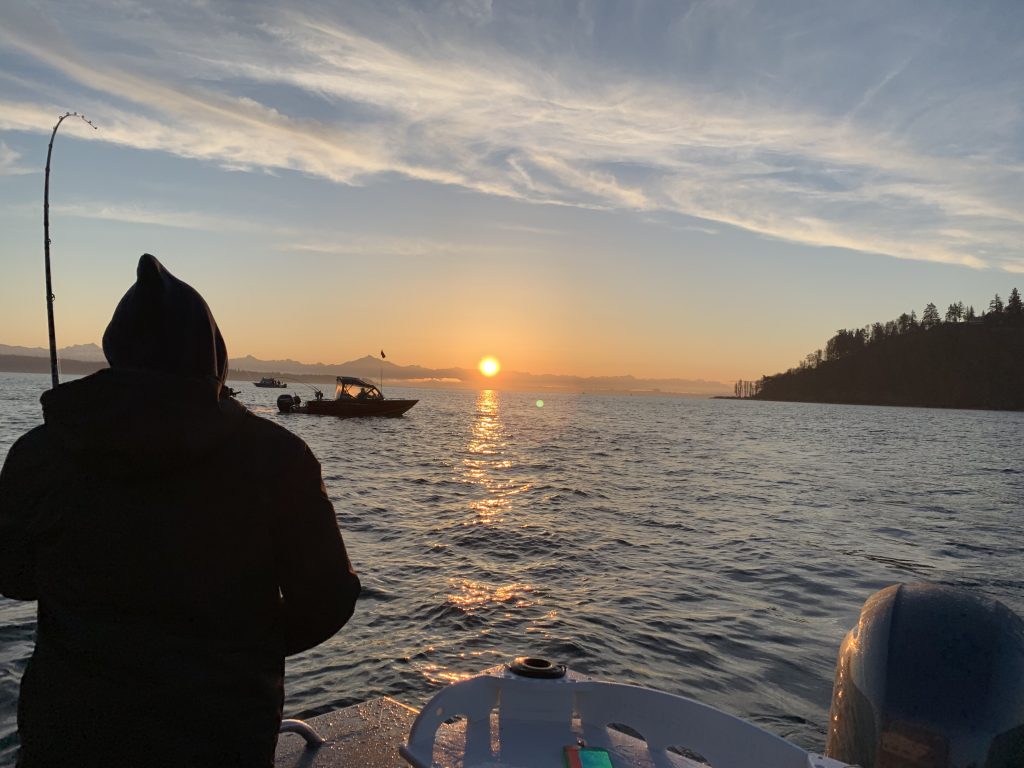Shad and coho are top choices to catch in the days ahead with ocean salmon fisheries set to begin very soon Leave a reply

It’s really starting to feel a lot like summer and hope springs eternal with all the fishing opportunities blooming around the Pacific Northwest.
Many are prepping their boats and fishing gear for the ocean salmon opener on June 22 where big surge of coho and fair number of kings are forecasted to arrive off the coast.
And the good news is that it appears salmon are already congregating in the marine waters from Neah Bay south to Ilwaco. The commercial troll fishery began in May and lousy weather has kept them from getting out early on but as of late success really ramped up.
“Last week was a good one for the commercial fleet,” said Wendy Beeghley, a WDFW coastal salmon manager. “There’s some fish around the north coast (off Neah Bay and La Push) so that is especially encouraging.”
“The chinook trollers in Area 2-10 (at Westport) ran into a blast of kings during a four-day period last week but now they’re gone,” Beeghley said. “It isn’t unusual for these migrating salmon to be there one day and gone the next. It sounded like the (chinook) weren’t too far offshore although they’re forced to fish outside of the (near-shore) crab pots since they don’t have the ability to zig-zag around them.”
The hatchery-marked coho season off Neah Bay, La Push, Westport and Ilwaco (Areas 1, 2, 3, and 4) is expected to best we’ve seen since 2015.
All four ports are open daily from June 22 through Sept. 30 or will close once each area’s catch quota is achieved. The daily limit at Ilwaco and Westport is two salmon and no more than one may be a chinook. The daily limit at La Push and Neah Bay is two salmon.
The total allowable sport and non-tribal commercial catch is 190,000 hatchery coho up considerably from 47,600 last year; and 52,500 chinook down slightly from 55,000. The Columbia River coho forecast is 1,009,600 compared to 349,000 in 2018.
Ilwaco has a 79,800 hatchery coho quota (21,000 in 2018) and a 7,150-chinook quota (8,000 in 2018); Westport is 59,050 (15,540) and 12,700 (13,100); La Push is 4,050 (1,090) and 1,100 (1,500); and Neah Bay is 16,600 (5,370) and 5,200 (3,024).
Here’s a clarification to a marine salmon fishing regulation for eastern Strait of Juan de Fuca (Area 6). Hatchery king fishing at Port Angeles is open July 1 to Aug. 15 from west of a true line north/south line through Number 2 Buoy immediately east of Ediz Hook (release chum, wild coho, and wild chinook). A chinook release area from July 1 through Aug. 15 is east of a true north/south line through the Number 2 Buoy immediately east of Ediz Hook (release all chinook, chum and wild coho). All of Area 6 is open for salmon fishing from Aug. 16 through Sept. 30 (release all chinook, chum and wild coho). Freshwater Bay is closed for salmon from July 1-Oct. 31; Port Angeles Harbor, Sequim Bay and Discovery Bay are closed for salmon from July 1-Aug. 15.

Columbia River shad return on a record pace
The shad count at Bonneville Dam on the Lower Columbia River appears to be headed for the record book as the early-season total is now a whopping 3,525,260.
Single-day counts were 292,097 on June 9; 183,872 on June 8; 173,772 on June 7; 362,927 on June 6; 412,448 on June 5; 315,678 on June 4; 335,463 on June 3; 352,186 on June 2; 342,480 on June 1; and 354,853 on May 31.
Yearly data shows anywhere from 1 to 5 million migrating into the big river. The 10-year average peak timing for shad usually occurs from early- to mid-June, but anglers will make the run south once daily shad counts hit 20,000-plus.
Some of the best fishing occurs along the shoreline just below Bonneville Dam, but shad are spread out in the Camas Slough, and from Washougal downstream to Kalama.
To access the best area below the dam, head east on Highway 14 about two miles past the town of North Bonneville, and take the right-hand turn by the transmission towers. The access road allows anglers about three miles of prime shoreline in either direction.
Shad tend to like a fast running current, and most fish usually are caught no further than 30 feet from shore.
Shad darts are the most effective lure, but red- and white-colored flies with a small hook, colored beads like red or a metallic silver or gold, small crappie-like jigs and small wobbler-type spoons or spinners will do the job.

Salmon options begin to swell
Closer to Seattle the coho fishery in central Puget Sound started off on the slow side but began to pick up this past week.
“It hasn’t been as hot as last year by any means, but there are some who’ve gotten into a pack of them,” said Gary Krein, owner of All-Star Charters in Everett.
Most of the coho were averaging 2 to 4 pounds, and the best action is happening around the northern portion of Jefferson Head and Kingston mainly out toward the yellow marker buoys in the shipping lanes.
Most are fishing at depths of 30 to 80 feet, and there are also some mature kings also being caught and released. Don’t want to jinx anything but the dogfish haven’t been thick and that will likely change before we know it.
The Tulalip Bubble Terminal Fishery within Area 8-2 is open each week from 12:01 a.m. Fridays through 11:59 a.m. Mondays only (closed on June 15 for a tribal ceremonial fishery). The bubble has been spotty at best although some anglers have managed to catch some kings in the 10- to 15-pound range.
Local anglers plying the waters of southern Puget Sound (Area 13) have been keeping quiet but word leaked out this past week that some hatchery kings were being caught off Point Fosdick and off Fox Island’s east side at Gibson Point, Toy Point and Fox Point. Area 13 is open year-round for salmon and has a revamped minimum size limit on hatchery chinook of 20 inches (22 inches was the standard in past years).
Further north, the Edmonds Pier is open year-round for salmon and tossing a variety of jigs or a Styrofoam float with a herring drifting underneath should produce some kings.
Last year’s early king fishery on the Skykomish River from mouth to the Wallace River was decent and is open through July 31. The Reiter Ponds area of the Skykomish is also open for hatchery steelhead fishing but has generated a mediocre catch at best.
The first sockeye opportunity begins June 16 through July 15 on the Skagit River from Memorial Highway Bridge to Gilligan Creek. Low water levels and flow will have a big effect on how well anglers catch sockeye in the river. The Skagit River and Baker Lake sockeye forecast is 33,737 (35,002 in 2018 with about 32,000 returning).
The Skagit from the Highway 530 Bridge at Rockport to Cascade River Road and from Cascade mouth to Rockport-Cascade Road Bridge is open now through July 15 for hatchery-marked chinook. Anglers will cast a gob of salmon eggs or a sand shrimp or egg combo. Others will use corkies and yarn.
Bottomfishing off the coast remains very good for lingcod and fair for halibut.
Halibut fishing off Ilwaco (Area 1) is open daily through June 20, and the nearshore fishery is open daily Mondays through Wednesdays only. Westport (Area 2) is open for halibut on June 20 only. Neah Bay and La Push (Areas 3 and 4) are open for halibut June 15, 20 and 22. In Puget Sound (Areas 5 to 10), the halibut fishery is open June 13, 15, 20, 22, 27 and 29. The daily limit is one halibut (annual catch is four halibut) with no minimum size limit.
Specific Dungeness crab seasons by marine catch areas of Puget Sound haven’t been set just yet and could be as soon as Monday (June 10), but what we do know is that season will begin on the Fourth of July!

